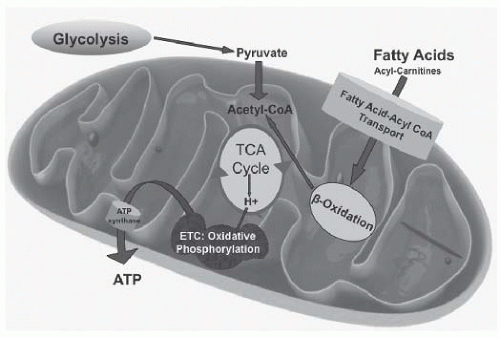Disorder |
Primary Features |
Additional Features |
NUCLEAR DNA MUTATIONS |
Alpers-Huttenlocher syndrome |
Hypotonia
Seizures
Liver failure |
Renal tubulopathy |
Leigh syndrome (LS) |
Subacute relapsing encephalopathy
Cerebellar, brainstem signs
Infantile onset |
Basal ganglia lucencies
Maternal lineage history of neurologic disease, Leigh syndrome, or increased spontaneous abortions |
Infantile myopathy and lactic acidosis (fatal and nonfatal forms) |
Hypotonia in 1st y of life
Feeding and respiratory difficulties |
Fatal form may be associated with a cardiomyopathy and/or de Toni-Fanconi-Debre syndrome |
MITOCHONDRIAL DNA MUTATIONS |
Progressive external ophthalmoplegia (adPEO and arPEO) |
External ophthalmoplegia
Bilateral ptosis |
Mild proximal myopathy
Compatible with a normal life span |
Kearns-sayre syndrome (KSS) |
PEO onset at age <20 y
Pigmentary retinopathy
One of the following: CSF protein >1 g/L Cerebellar ataxia Heart block |
Bilateral deafness
Myopathy
Dysphagia
Diabetes mellitus
Hypoparathyroidism
Dementia |
Neurogenic weakness with ataxia and retinitis pigmentosa (NARP) |
Late-childhood or adultonset peripheral neuropathy
Ataxia
Pigmentary retinopathy |
Basal ganglia lucencies
Abnormal electroretinogram
Sensorimotor neuropathy |
Myoclonic epilepsy with ragged-red fibers (MERRF) |
Myoclonus
Seizures
Cerebellar ataxia
Myopathy |
Dementia
Optic atrophy
Bilateral deafness
Peripheral neuropathy
Spasticity
Generalized lipomatosis |
Leber hereditary optic neuropathy (LHON) |
Subacute painless b/l visual failure
M:F, 4:1
Median age of onset 24 y |
Dystonia
Cardiac preexcitation syndromes |
Mitochondrial encephalomyopathy with lactic acidosis and stroke-like episodes (MELAS) |
Stroke-like episodes at age <40 y
Seizures and/or dementia
Ragged-red fibers and/or lactic acidosis |
Diabetes mellitus
Cardiomyopathy (initially hypertrophic, later dilated)
Bilateral deafness
Pigmentary retinopathy
Cerebellar ataxia |
Pearson syndrome |
Sideroblastic anemia of childhood
Pancytopenia
Exocrine pancreatic failure |
Renal tubular defects |
Myoclonic epilepsy myopathy sensory ataxia (MEMSA or MIRAS) |
Myopathy
Seizures
Cerebellar ataxia |
Dementia
Peripheral neuropathy
Spasticity |
Coenzyme Q10 deficiency |
Encephalopathy, myopathy
Seizures, cerebellar ataxia
Cardiomyopathy
Renal failure |
Growth retardation
Early infancy LS (severe form)
Late onset: myopathy, ataxia, seizures, mild encephalopathy |
Modified from genereviews.org. Chinnery PF. Mitochondrial Disorders Overview. 2000 Jun 8 [Updated 2010 Sep 16]. In: Pagon RA, Adam MP, Bird TD, et al., editors. GeneReviewsTM [Internet]. Seattle (WA): University of Washington, Seattle; 1993-2013. Available from: http://www.ncbi.nlm.nih.gov/books/NBK1224/ |









